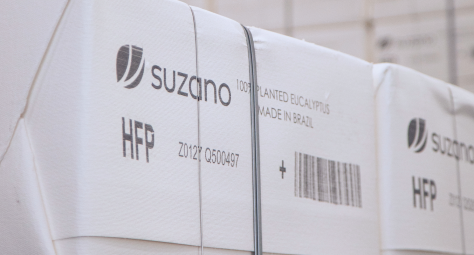sobre o que você deseja falar?


perguntas, sugestões ou problemas técnicos envolvendo a plataforma

informações sobre a empresa




SASB Dimension
Waste ManagementSASB Code
RR-PP-140a.1SASB Code
RT-CP-140a.1SASB Sector
Pulp & Paper ProductsSASB Sector
Containers and PackagingGRI Dimension
Material TopicsGRI Dimension
EconomicGRI Dimension
EnvironmentalGRI Code
3-3GRI Code
303-1GRI Code
303-3GRI Code
303-5Stakeholder
PlanetTCFD
Suzano and the TCFDTCFD
Related IndicatorsCommitments to Renewing Life
Water management in industrial operations
Governance on the topic
In 2020, Suzano announced its Commitments to Renew Life (CPRVs), which includes a goal to reduce specific water withdrawal by 15% by 2030. After making this commitment, the company established a governance framework for the initiative: annual targets were set for each industrial unit, and the results are monitored within the business units.
The company has established an Industrial Environment Working Group (GTMAI) that evaluates the results monthly. Each industrial operation monitors water management indicators weekly with the Board of Directors and Industrial Management. The results are shared at monthly meetings with all unit employees to encourage their involvement in the issue. In some industrial operations, consumption targets have been set by sector, specifying limits for each stage of the production process. Sector performance is assessed during routine production meetings.
Water management risks associated with water collection, consumption, and disposal
The management of water resources is a crucial issue for Suzano, involving risk analysis and strategies to reduce the impacts of water usage in industrial operations. According to the Aqueduct Water Risk Analysis tool, most of the company's units are located in cities with low water stress (less than 10%), such as the Aracruz (ES), Cachoeiro de Itapemirim (ES), Imperatriz (MA), Jacareí (SP), Limeira (SP), Mucuri (BA) and Três Lagoas (MS) units. The Belém (PA) plant is located in an area with medium-low water stress (between 10% and 20%). In contrast, the Mogi das Cruzes (SP), Ribas do Rio Pardo (MS), Rio Verde (SP), and Suzano (SP) plants are located in an area considered to have medium-high water stress (between 20% and 40%).
The only unit in an area with high water stress levels (between 40% and 80%) is in Maracanaú, Ceará (CE). This situation is primarily due to the city's significant urbanization, as it is near Fortaleza, Ceará. However, the volume of water extracted by the tissue conversion unit is notably low, which does not impact other types of water usage and ensures the continuity of its operations remains secure.
Historically, the facilities in Aracruz, Jacareí, and Mucuri have been significantly impacted by climatic risks affecting water availability. As a result, strategic actions have been reviewed to address potential issues related to water withdrawal. Suzano is working to raise awareness among its partners about this critical issue and aims to achieve positive environmental outcomes. The solution to the water crisis requires a multifaceted approach, including the efficient use and management of natural resources and implementing practices to mitigate potential risks.
Suzano's involvement in the river basin committees where its industrial units are situated is essential. This participation aims to ensure that its operations are aligned with the management plans for each basin, ultimately contributing to positive outcomes for all stakeholders.
In this context, through local teams and leadership, the company participates in the following committees: Alto Tietê Hydrographic Basin Committee; Rio Doce Hydrographic Basin Committee (CBH-Doce); Litoral Centro Norte Hydrographic Basin Committee; Paraíba do Sul River Basin Committee (Ceivap); Piracicaba, Capivari and Jundiaí Basin Committee (CPCJ); Pardo River Basin Committee (CBH Pardo), Tocantins River Basin Committee; and the National Water and Sanitation Agency (ANA) Crisis Committee.
Suzano has made significant contributions, including defining the minimum effluent flows that can be maintained in the Paraíba do Sul River Basin to ensure adequate reserve levels. The company also played a key role in establishing the operating rules for the hydroelectric plants (HPPs) in the Tocantins River Basin, aiming to maximize water storage in the Serra da Mesa HPP reservoir, the largest reservoir in the world by capacity.
The water stock in this reservoir will enhance the basin's resilience during extended droughts. Thanks to implementing various preventive and adaptive measures at Suzano's industrial units, there have been no reduced production or stoppages due to a lack of water resources.
Performance in 2024
In 2024, Suzano's total water withdrawal reached 347,649,940.3 cubic meters, which aligns with the expected volume due to the start-up of the new Ribas do Rio Pardo unit. This represents an increase in absolute water withdrawal of only 7.6%. Conversely, we achieved a 2% reduction in our specific water abstraction rate (m³/t), indicating that we used less water per ton of product produced. Supporting this positive outcome for 2024, our specific water consumption during this period was 6.58 m³/t, which is 2% higher than in 2023.
Suzano's industrial units operate as sustainable water reservoirs. The term "sustainable reservoir" refers to their ability to recirculate water within the production process, where approximately 80% of the captured water is reused and returned to the environment as treated effluent. This recirculation is facilitated by various internal water reuse strategies, including using cooling water, hot water, condensates (steam and liquor), bleaching filtrates, white water from drying machines, and internal recirculations at the water treatment plant itself.
The company operates within the reference limits of international best practices, such as Integrated Pollution Prevention and Control (IPPC) and the International Finance Corporation (IFC), which stipulate limits ranging from a minimum of 25 m³/tsa to 50 m³/tsa.
Water management in forestry operations
Forests play a crucial role in providing fresh water and can offer nature-based solutions to social challenges related to water management. Suzano acknowledges that water is essential for maintaining ecosystem balance and ensuring the sustainability of its operations. The company is committed to providing the availability and access to quality water for various users within its watersheds. This commitment is realized through the following actions:
Guidelines are established to monitor water resources in terms of water management. This allows for assessing water quality and availability in bodies of water affected by Suzano's forest management practices. Additionally, these guidelines help inform decision-making processes, such as enhancing and adapting forest management strategies and ensuring compliance with the company's established standards.
Proper forest management enhances various ecosystem services, such as regulating water and maintaining water quality. This supports forestry production and ensures a high-quality water supply to the multiple users within the watersheds where we operate.
Currently, forest water management considers demands associated with current legislation and/or environmental license conditions; forest certification requirements; international agreements [such as the Sustainable Development Goals (SDGs), the UN Decade of Restoration, and the 20x20 Initiative]; sectoral and multilateral agreements [such as forest forums and the Brazilian Tree Industry (Ibá)]; partnerships with universities [Luiz de Queiroz College of Agriculture, University of São Paulo (Esalq/USP)], companies (P&G, SONOCO), government (IEF) and NGOs [The Nature Conservancy (TNC) and Instituto Terra]; demands from stakeholders (such as overlapping water use); and global platforms for publicizing impact management [CDP, Dow Jones Sustainability Index (DJSI), Global Report Initiative (GRI), WaterFootprint, among others].
Suzano's management and commitments
Eucalyptus is the primary raw material in Suzano's production process. It consumes water and carbon dioxide, performs photosynthesis, and returns water and oxygen to the atmosphere. The production cycle lasts six to seven years.
Forestry operations are seasonal and itinerant, affecting planting and transportation processes. During the initial days of eucalyptus planting, watering the seedlings is essential. After this initial period, water is primarily needed to dampen the roads near communities and neighboring residents to control dust during wood transportation. This water usage is typically required six to seven years after planting.
The management and use of water in forestry, harvesting, and logistics are guided by forestry planning, which considers regulations set by state public agencies and the shared water needs of neighboring communities. Consequently, the amount of water allocated for operations is determined based on the availability of water resources and the volume required by other users. The management and use of water in forestry, harvesting, and logistics are guided by forestry planning, which considers regulations set by state public agencies and the shared water needs of neighboring communities. Consequently, the amount of water allocated for operations is determined based on the availability of water resources and the volume required by other users.
The Forestry Environment department supervises the water usage of the forestry operation. They check the environmental agency's licenses, allowed water withdrawal amounts, the actual volume extracted at each site, and its geographical location. This process helps quickly identify, control, and correct any deviations. Suzano's forestry base is across several significant river basins in Brazil, each with unique resources, environments, uses, land occupations, and water demands.
The company aims to enhance the efficient use of water in its forests and promote hydrosolidarity while addressing the diversity of challenges it faces. In early 2020, it established a critical water resource value (CPRV) to “increase water availability in 100% of critical watersheds by 2030.” Critical watersheds are defined as areas that experience water scarcity due to factors such as climate, soil type, and land use. Suzano has mapped these critical watersheds across all its forestry units, considering local water resources, climate conditions, strategic priorities, and social aspects.
The company is concentrating its efforts on watersheds with significant occupation by its operations (equal to or greater than 30%) so that the forest management practices adopted can have an effect and generate the best results regarding the watersheds' water availability.
To effectively implement technical management practices in the forest and comprehend the supply and demand of water in the watersheds, Suzano has established a comprehensive environmental monitoring network. The Micro Basins Project was initiated in 1990, and currently, the company operates 15 experimental micro basins equipped with sensors that measure water balance. This project enhances our understanding of the relationships and impacts of forest management in areas that represent Suzano's production model across all forestry units.
The company operates a network of 72 meteorological stations and 95 public stations throughout its forestry base. This setup allows for assessing climate effects on forest productivity and water supply in river basins. Additionally, the company has six flow towers equipped with instruments that monitor water and carbon balances at very high frequencies.
Suzano has partnered with the Cooperative Program on Environmental Monitoring in Watersheds (Promab) for over ten years. Coordinated by the Forest Hydrology Laboratory within the Forest Sciences Department at Esalq/USP, this initiative involves collaboration between sector and university companies. The program plays a crucial role in generating knowledge about best management practices, promoting transparency within the business through numerous scientific publications, and encouraging future research on sustainability and environmental issues.
The company has an internal policy with an Environmental Aspects and Impacts Management Matrix. This matrix identifies forest management activities that could affect water quality and availability and establishes control measures accordingly. To ensure compliance, periodic monitoring is conducted to assess water quality and availability at Suzano's facilities. Sampling points have been strategically located to represent the production and coverage model, allowing for evaluating potential relationships between the company's eucalyptus planting and harvesting areas and the water resources in the surrounding watershed. This monitoring focuses on key factors such as water flow, water quality, rainfall, and laboratory test results.
Managing and identifying risks and opportunities
A state public agency regulates water use for operational activities and sets the maximum amount a company is allowed to use. Unauthorized water abstraction—whether it occurs in areas lacking permission from the agency or exceeds the permitted daily volume—poses environmental risks. Such actions can jeopardize water availability, contaminate soil and water sources, and result in legal consequences, including administrative or criminal liabilities.
The risks associated with water consumption are reduced downstream flow, erosion, and siltation, contamination due to effluent disposal, and the imposition of fines at state and federal levels due to infringements of legislation related to water resources.
The following tables provide the following data:
| 2020 | 2021 | 2022 | 2023⁴ | 2024 | |||||||||||
|---|---|---|---|---|---|---|---|---|---|---|---|---|---|---|---|
| Total water abstracted | Total water abstracted in water-stressed areas | Percentage of water abstracted in water-stressed areas | Total water abstracted | Total water abstracted in water-stressed areas | Percentage of water abstracted in water-stressed areas | Total water abstracted | Total water abstracted in water-stressed areas | Percentage of water abstracted in water-stressed areas | Total water abstracted | Total water abstracted in water-stressed areas³ | Percentage of water abstracted in water-stressed areas | Total water abstracted | Total water abstracted in water-stressed areas³ | Percentage of water abstracted in water-stressed areas | |
|
Surface waters, including wetlands, rivers and lakes |
312,706,547.20 |
29,406,242.20 |
9.40% |
322,378,551.40 |
28,965,102.50 |
9.00% |
315,491,634.10 |
28,790,518.90 |
9.10% |
321,498,519.80 |
0.00 |
0.00% |
351,527,810.10 |
0.00 |
0.00% |
|
Groundwater/water tables |
1,404,884.20 |
0.00 |
0.00% |
1,389,042.80 |
0.00 |
0.00% |
1,307,292.80 |
0.00 |
0.00% |
1,315,302.06 |
0.00 |
0.00% |
1,477,854.60 |
0.00 |
0.00% |
|
Rainwater |
767,032.40 |
0.00 |
0.00% |
270,809.20 |
0.00 |
0.00% |
221,394.00 |
0.00 |
0.00% |
286,055.14 |
0.00 |
0.00% |
213,745.20 |
0.00 |
0.00% |
|
Third-party water² |
n/d |
n/d |
n/d |
n/d |
n/d |
n/d |
n/d |
n/d |
n/d |
4,596.00 |
1,597.00 |
34.70% |
4,493.00 |
1,923.00 |
42.80% |
|
Total |
314,878,463.80 |
29,406,242.20 |
9.30% |
324,038,403.40 |
28,965,102.50 |
8.90% |
317,020,320.90 |
28,790,518.90 |
9.10% |
323,104,473.00 |
1,597.00 |
0.00% |
353,223,902.80 |
1,923.00 |
0.00% |
| 2020 | 2021 | 2022 | 2023 | 2024² | |||||||||||
|---|---|---|---|---|---|---|---|---|---|---|---|---|---|---|---|
| Total water abstracted | Total water abstracted in water-stressed areas | Percentage of water abstracted in water-stressed areas | Total water abstracted | Total water abstracted in water-stressed areas | Percentage of water abstracted in water-stressed areas | Total water abstracted | Total water abstracted in water-stressed areas | Percentage of water abstracted in water-stressed areas | Total water abstracted | Total water abstracted in water-stressed areas | Percentage of water abstracted in water-stressed areas | Total water abstracted | Total water abstracted in water-stressed areas | Percentage of water abstracted in water-stressed areas | |
|
Surface waters, including wetlands, rivers and lakes |
1,506,967.68 |
n/d |
n/d |
1,499,520.94 |
0.00 |
0.00% |
1,171,062.73 |
2,134.69 |
0.14% |
1,409,352.07 |
0.00 |
0.00% |
2,119,767.00 |
0.00 |
0.00% |
|
Groundwater/water tables |
299,893.36 |
n/d |
n/d |
141,445.05 |
0.00 |
0.00% |
145,135.00 |
0.00 |
0.00% |
187,183.60 |
0.00 |
0.00% |
195,071.00 |
0.00 |
0.00% |
|
Rainwater |
0.00 |
n/d |
n/d |
0.00 |
0.00 |
0.00% |
0.00 |
0.00 |
0.00% |
0.00 |
0.00 |
0.00% |
0.00 |
0.00 |
0.00% |
|
Total |
1,806,861.04 |
n/d |
n/d |
1,640,965.99 |
0.00 |
0.00% |
1,316,197.73 |
2,134.69 |
0.13% |
1,596,535.67 |
0.00 |
0.00% |
2,314,838.00 |
0.00 |
0.00% |
| 2020 | 2021 | 2022 | 2023³ | 2024⁴ | |
|---|---|---|---|---|---|
|
Total amount |
65,801,937.10 |
71,034,801.50 |
62,182,731.60 |
69,770,348.52 |
78,390,997.50 |
|
Specific (m³/t) |
6.30 |
6.30 |
5.50 |
6.45 |
6.58 |
|
In areas of water stress² |
6,102,257.40 |
5,717,193.90 |
6,025,018.60 |
599.00 |
0.00 |
| 2020 | 2021 | 2022 | 2023 | 2024³ | |
|---|---|---|---|---|---|
|
Total |
1,806,861.04 |
1,640,965.99 |
1,651,233.91 |
1,596,535.67 |
2,314,838.00 |
|
In areas of water stress² |
N/D |
0.00 |
2,134.69 |
0.00 |
0.00 |
| 2020 | 2021 | 2022 | 2023 | 2024 | |
|---|---|---|---|---|---|
| overall number | overall number | overall number | overall number | overall number | |
|
Total |
53 |
65 |
76 |
85 |
77 |
| 2020 | 2021 | 2022 | 2023 | 2024 | |
|---|---|---|---|---|---|
| overall number | overall number | overall number | overall number | overall number | |
|
Total |
n/d |
n/d |
n/d |
10 |
10 |
Depending on the process, the indicators are measured by online analyzers or manually. Suzano undergoes the ISO 14001 and ISO 9001 verification process, focusing on verifying the measuring equipment's accuracy.
Rainwater is collected at the Ribas do Rio Pardo and Três Lagoas units in Mato Grosso do Sul.